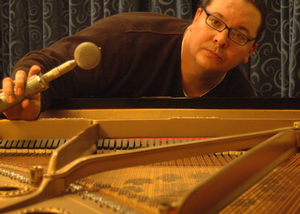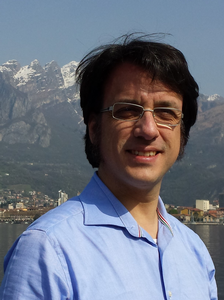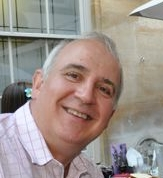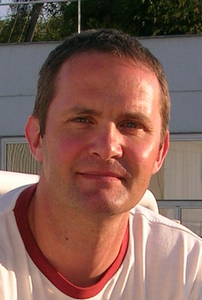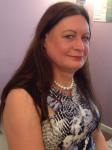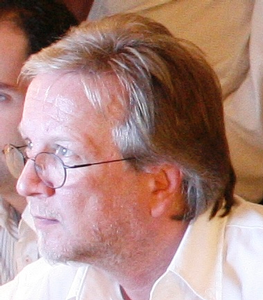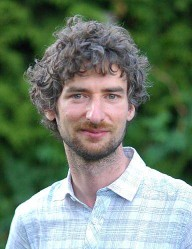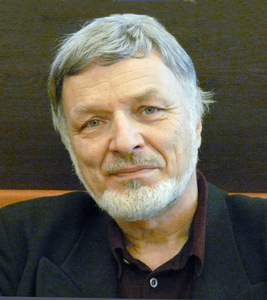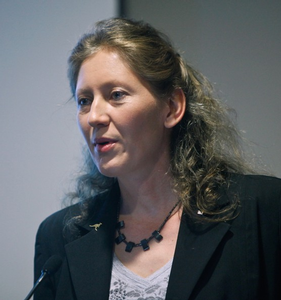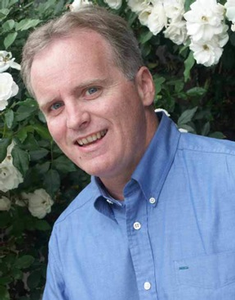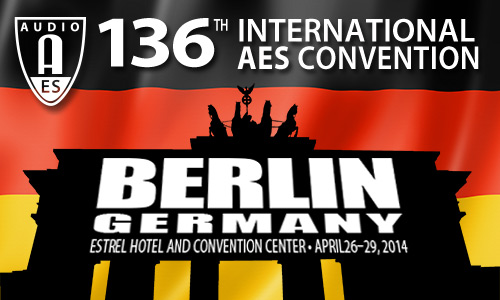
AES Berlin 2014
Tutorial Details
Saturday, April 26, 09:30 — 11:00 (Estrel Hall A)
T1 - The Drum Kit: What a Recordist Ought to Know
Presenter:Alex Case, University of Massachusetts Lowell - Lowell, MA, USA
Abstract:
Audio engineers, in order to serve the artists they record, must have deep knowledge of the instruments they track and mix. The greatest of tests is the pop/rock drum kit. Drummers obsess about every detail of their instrument. Engineers do the same with every detail of their studio. This tutorial merges those obsessions, so that a recording engineer can be more fully informed about the key drivers of sound quality for the drum kit. Know the instrument first, and let that drive your decisions for recording and mixing the instrument.
 | This session is presented in association with the AES Technical Committee on Recording Technology and Practices |
Saturday, April 26, 11:30 — 13:00 (Estrel Hall B)
T2 - Audio Forensics— What's It All About
Presenters:Eddy B. Brixen, EBB-consult - Smorum, Denmark; DPA Microphones /A/S - Allerød, Denmark
Christopher Hicks, CEDAR Audio Linited - Cambridge, United Kingdom
Abstract:
Working with audio forensics is serious business. Depending on the work of the forensics engineer, people may eventually end up in prison. This tutorial will present the kind of work related to the field. This covers fields as acoustics, when audio analysis can be a part of the crime scene investigation. Voice acoustics: Who was speaking? Electro acoustics: Checking data on tapes, discs or other data storage media. Recording techniques: Is this recording an original production or is it a copy of another’s work? Even building acoustics and psycho acoustics, when the question is raised: Who could hear what? However, the most important “everyday work” of the audio forensics engineers is cleaning of audio recordings and providing transcriptions. In this tutorial state-of-the-art sound cleaning will be demonstrated.
 | This session is presented in association with the AES Technical Committee on Audio Forensics |
Saturday, April 26, 14:30 — 16:00 (Estrel Hall B)
T3 - Tuning Your Studio - Acoustic Analysis of Small Rooms for Music
Presenter:Lorenzo Rizzi, Suono e Vita - Acoustic Engineering - Lecco, Italy
Abstract:
Music production nowadays is made in smaller and smaller rooms but the focus on audio technologies almost removes the importance of room acoustics. We’ll deal with the fundamentals of sweet-spot response measurements for acoustic optimization of the listening system and speaker/dubbing/rehearsing rooms. Why small rooms for music do not follow Sabine’s laws of acoustics. Are classical acoustical parameters (e.g., RT, and the others) of any relevance?
The tutorial will also cover measuring impulse and frequency responses and discuss the importance of spatial averaging and transients. A number of room measurement and system case studies will be presented that illustrate procedures such as balancing the channels, the influence of room modes in the frequency and in the time domain, stereo triangle optimization, microphone positioning, echogram analysis, the importance of scattering and diffraction—tips to improve the room quality and technical targets
 | This session is presented in association with the AES Technical Committee on Acoustics and Sound Reinforcement |
Saturday, April 26, 16:30 — 18:00 (Estrel Hall B)
T4 - Speech Transmission Index (STI) Measurements in Practice
Presenters:Peter Mapp, Peter Mapp Associates - Colchester, Essex, UK
Ben Kok, BEN KOK - acoustic consulting - Uden, The Netherlands
Abstract:
The Speech Transmission Index is today the most widely used international measure of potential speech intelligibility. In particular it is cited and performance requirements are incorporated in many national & international sound system and emergency sound system / voice alarm system standards and codes of practice. Few standards however state how STI performance should be measured and the equipment required to carry out such measurements. The workshop will discuss measurement techniques, data analysis, measurement equipment (including smart phone apps), equipment calibration, and the capture and logging of measurement data. The workshop will be given by Dr. Peter Mapp, a leading authority on STI measurement and the current chairman of IEC 60268-16—the International Standard relating to STI.
 | This session is presented in association with the AES Technical Committee on Acoustics and Sound Reinforcement |
Sunday, April 27, 09:00 — 10:30 (Estrel Hall B)
T5 - Handling and Storage of Audiovisual Carriers
Presenter:Dietrich Schüller, Phonogrammarchiv - Vienna, Austria
Abstract:
This tutorial will provide a preview of the IASA technical recommendation TC-05 that will be published later this year. Special focus will be given on some less known facts, e.g., the role of the production process (and failures thereof) on the longevity of audiovisual carriers.
 | This session is presented in association with the AES Technical Committee on Archiving Restoration and Digital Libraries |
Sunday, April 27, 14:15 — 16:15 (Estrel Hall B)
T6 - Linear Power Amplifiers Revisited: From Picowatts to a Kilowatt - A Practical Guide to Driving both Headphones and Loudspeakers Properly
Presenter:John Dawson, ARCAM - Waterbeach, Cambridge, UK; Jade Electronics - Landbeach, Cambridge, UK
Abstract:
This is a tutorial for students and working engineers covering classic and modern amplification design problems/solutions relating to interactions with a complex load and relating to in-ear balanced armature devices, over the ear headphones, and all types of speakers with 120 dB dynamic range. This would tackle class A, A/B, and related analog classes rather than class D.
 | This session is presented in association with the AES Technical Committee on High Resolution Audio |
Sunday, April 27, 14:30 — 16:30 (Estrel Hall A)
T7 - Music Production For Film — A Master Class
Presenters:Brian McCarty, Coral Sea Studios Pty. Ltd - Clifton Beach, QLD, Australia
Christine Aufderhaar, Christine Aufderhaar - Berlin, Germany
Abstract:
One of the largest attendance Master Classes in New York and Rome is back. Watch and hear a world-famous film composer develop the soundtrack for a feature film.
 | This session is presented in association with the AES Technical Committee on Audio for Cinema |
Monday, April 28, 09:00 — 10:00 (Estrel Hall C1)
T8 - Auro 3D Recording and Mixing of Classical Music
Presenter:Malgorzata Albinska-Frank, Tonstudio arton, Das Tonstudio für klassische Musik - Basel, Switzerland
Abstract:
In this tutorial, practical and aesthetic aspects of Auro 3D production for classical music will be discussed. These include: •Discussing the design of the Auro 3D sound image •Microphone Setup •Playback (construction of the speaker, influence of the room acoustics) •Mixing (aesthetics of the design - effect or naturalness)
Monday, April 28, 09:00 — 10:30 (Estrel Hall B)
T9 - All You Need Is LUFS
Presenter:Florian Camerer, ORF - Austrian TV - Vienna, Austria; EBU - European Broadcasting Union
Abstract:
Loudness normalization is rapidly becoming the new standard for leveling audio. The transition has started in TV and is currently moving into other areas such as radio and the music world. In this session the basics will be summarized, and then a detailed view will be offered on some specific areas like the relative gate, the speech gate, recent developments in radio and more. Join the chairman of the EBU loudness group for a LUFSly ride along the river of audio harmony….
Monday, April 28, 10:30 — 12:30 (Estrel Hall C1)
T10 - Dither and Noise Shaping in Digital Audio: Hows and Whys
Presenter:Jamie Andrea Shyla Angus, University of Salford - Salford, Greater Manchester, UK
Abstract:
This tutorial investigates finite-word-length in digital audio: how it differs from analog audio, the side-effects of signal quantization, and how the adverse effects of quantization can be diminished via dither and/or noise shaping. The tutorial presents the theory of quantization along with a live interactive audio demonstrations that illustrates the motivation behind the theory.
 | This session is presented in association with the AES Technical Committee on Signal Processing |
Monday, April 28, 10:30 — 12:00 (Estrel Hall B)
T11 - Speech Intelligibility in Broadcasting
Presenter:Askan Siegfried, NDR - Hamburg, Germany
Abstract:
The higher awareness of audio in TV because of the loudness revolution has led to other areas in audio to step into the spotlight again. One of those is the intelligibility of speech, which parameters influence it and how it can be improved. After examining the potential causes for speech intelligibility problems, advice will be given on best practice how to ensure your audience doesn’t have to strain to understand what is being said in a program.
Monday, April 28, 12:15 — 13:15 (Estrel Hall C2)
T12 - Beethoven's 9th in 3-D Audio with Digital Microphones
Presenter:Gregor Zielinsky, Sennheiser Electronic GmbH & Co. KG - Germany
Abstract:
In Part 1 of this tutorial the difficulties and specialities of recording Beethoven's 9th Symphony in Auro 3D, with the Seoul Philharmonic Orchestra under Maestro Myung-whun Chung, will be presented. This will include an explanation of the digital microphone setup.
Part 2 of the tutorial will introduce a "one-size fits all" algorithm that can be used by consumers for upmixing from 2-D to 3-D automatically. The algorithm can be used in a professional version with the option of parameter tuning for professional upmix mastering. The algorithm was used for the "David Bowie is..." exhibition, which will be presented in Berlin 2014 as well as in other worldwide locations such as London, Chicago, Sao Paulo, and more.
The recording and the algorithm upmixing technique can be listened to in the "Recording Beethoven's 9th in 3D plus Upmix techniques" session.
Monday, April 28, 13:30 — 14:30 (Estrel Hall C1)
T13 - Perceptually Motivated Filter Design with Applications to Loudspeaker-Room Equalization
Presenter:Balázs Bank, Budapest University of Technology and Economics - Budapest, Hungary
Abstract:
Digital filters are often used to model or equalize acoustic or electroacoustic transfer functions. Applications include headphone, loudspeaker, and room equalization, or modeling the radiation of musical instruments for sound synthesis. As the final judge of quality is the human ear, filter design should take into account the quasi-logarithmic frequency resolution of the auditory system. This tutorial presents various approaches for achieving this goal, including warped FIR and IIR, Kautz, and fixed-pole parallel filters, and discusses their differences and similarities. It also shows their relation to fractional-octave smoothing, a method used for displaying transfer functions. With a better allocation of the frequency resolution and filtering resources, these methods require a significantly lower filter order compared to straightforward FIR and IIR designs at a given sound quality.
 | This session is presented in association with the AES Technical Committee on Signal Processing and AES Technical Committee on Loudspeakers and Headphones |
Monday, April 28, 14:00 — 15:30 (Estrel Hall B)
T14 - Location Sound 101
Monday, April 28, 16:00 — 18:00 (Estrel Hall B)
T15 - Fundamental Knowledge about Microphones
Presenter:Joerg Wuttke, Joerg Wuttke Consultancy - Pfinztal, Germany
Abstract:
Even a professional with many years of experience might enjoy reviewing the basics of acoustics and the operating principles of microphones. This tutorial also includes a discussion of technical specifications and numerous practical issues.
- Introduction: Vintage technology and the future; physics and emotion; choosing a microphone for a specific application
- Basic acoustics: Sound waves; frequency and wavelength; pressure and velocity; reflection and diffraction; comb filter effects; direct and diffuse sound
- Basic evaluations: Loudness and SPL; decibels; listening tests; frequency/amplitude and frequency/phase response; frequency domain and time domain
- How microphones work: Pressure and pressure-gradient transducers; directional patterns; some special types (boundary layer microphones and shotguns)
- Microphone specifications: Frequency responses (plural!); polar diagrams; free-field vs. diffuse-field response; low- and high-frequency limits; equivalent noise, maximum SPL and dynamic range
- Practical issues: Source and load impedance; powering; wind and breath noise
 | This session is presented in association with the AES Technical Committee on Microphones and Applications |
Monday, April 28, 16:00 — 17:30 (Estrel Hall C2)
T16 - Special Challenge Metadata: Preserving the Collection Oskar Sala or … How to Safeguard Hitchcock's Birds
Presenter:Nadja Wallaszkovits, Phonogrammarchiv, Austrian Academy of Science - Vienna, Austria
Abstract:
Oskar Sala (1910 - 2002) was a German musician, scientist, and a pioneer of electronic music. He played and further developed the trautonium, a predecessor of the synthesizer. By enhancing and modifying this instrument Sala was able to create totally new sounds and effects. He composed the scores for more than 300 films and created the effect soundtrack for Alfred Hitchcock's film The Birds, receiving many awards for his works. After his death he left, among others, a collection of about 1200 analog magnetic audio tapes which are stored in the archives of Deutsches Museum in Munich.
Oskar Sala fully exploited all the possibilities of the analog tape technology, using impressive experimental approaches. His tapes have become artworks themselves, as they comprise a unique richness of very special and specific metadata: most of the tapes are cut up to 200 times per reel, and he used them as a (more or less readable) notebook. Such and many more surprises made the adequate safeguarding and digitization of the collection a unique undertaking. The collection has been successfully digitized, financed by KUR – Programme for the Conservation of Moveable Cultural Assets (Germany) and under the consultancy of the Phonogrammarchiv Vienna.
The workshop outlines the various challenges of this project and discusses the parameters and practical problems of the audio transfer, as well as the strategy of safeguarding the richness of metadata by use of high definition video recording. Finally a database is shown that merges the complete digitized works of Oskar Sala and provides comprehensive access to the material for the first time.
 | This session is presented in association with the AES Technical Committee on Archiving Restoration and Digital Libraries |
Tuesday, April 29, 11:00 — 12:30 (Estrel Hall C1)
T17 - Audio Networks 1.1: What Audio People Need to Know about Networks
Presenters:John Grant, Nine Tiles - Cambridge, UK
Mark Yonge, AES - Blakeney, Gloucestershire, UK
Abstract:
Networked audio in a professional environment is not the same as delivering MP3 music over the Internet. The differences are mainly concerned with assuring professional performance criteria despite a much larger quantity of audio data. When, for example, would you communicate using a network in preference to a traditional point-to-point connection, like AES3, AES10 (MADI), or analog?
This tutorial is aimed at audio engineers who may have used networks for administration but are now looking to understand the details of networking professional audio. This will be a useful primer for the AES67 workshops later in the day. It will explore usefulness of the network layer model, time delays (latency) in specific layers, and overall end-to-end latency in audio applications.
Tuesday, April 29, 11:30 — 13:30 (Estrel Hall B)
T18 - Teaching Sample and Object Based Audio DSP via Matlab
Presenter:Jamie Andrea Shyla Angus, University of Salford - Salford, Greater Manchester, UK
Abstract:
This tutorial describes and demonstrates how one can teach sample based audio signal processing to undergraduates who are meeting Audio DSP for the first time. Unlike many matlab-based courses, this tutorial demonstrates how you can use it to teach both sample by sample based processing that is theoretically capable of handling an infinite data stream as well as an object focused approach that is both modular, extendable, and programmable in non-object orientated languages. It will also discuss how this might be done in languages other than matlab. The presentation will be interactive and will have a Q&A session.
 | This session is presented in association with the AES Technical Committee on Signal Processing |
Tuesday, April 29, 12:45 — 14:15 (Room Paris)
T19 - The Perception and Measurement of Headphone Sound Quality: Do Listeners Agree on What Makes a Headphone Sound Good?
Presenter:Sean Olive, Harman International - Northridge, CA, USA
Abstract:
Consumers are experiencing more of their audio content through headphones connected to mobile devices. Last year, headphone sales were $8.2 billion worldwide and continue to grow. Premium headphones (>$100) now account for 90% of the annual revenue growth. Market research indicates sound quality is a driving factor in headphone purchases with brand and fashion also being important factors among younger consumers. Yet, ironically the science behind what makes a headphone sound good and how to measure it is poorly understood. This, combined with the lack of perceptually meaningful headphone standards may explain why purchasing a headphone today is like playing Russian roulette with your ears. The magic bullet to achieving more consistent headphone sound quality is science.
The results of research conducted to better understand the relationship between consumers’ perceived sound quality and acoustic performance show that when the influence of brand, fashion, and celebrity endorsement is removed from headphone tests, listeners generally agree on what makes a headphones sound good, and their preferences can be correlated with acoustic measurements. Come and hear what we’ve learned.
